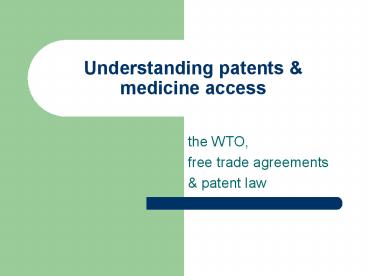Understanding patents - PowerPoint PPT Presentation
1 / 19
Title:
Understanding patents
Description:
Trade-Related Aspects of Intellectual Property Rights (TRIPS) ... countries in Africa and the Caribbean: Botswana, Cote d'Ivoire, Ethiopia, Guyana, ... – PowerPoint PPT presentation
Number of Views:171
Avg rating:3.0/5.0
Title: Understanding patents
1
Understanding patents medicine access
- the WTO,
- free trade agreements
- patent law
2
Key terms
- The World Trade Organization (WTO)
- Trade-Related Aspects of Intellectual Property
Rights (TRIPS) - Compulsory licensing government gives
compan(ies) permission to produce generics - Parallel importing countries resell patented
drugs to other countries
3
Arent generics illegitimate?
Who paid for the RD on AIDS drugs? Taxpayers
did.
Source Harvard Med, 2000
4
Wrong assumption 1 High price High
production cost
Source Doctors Without Borders, 2001
5
Wrong assumption 2 Profits are going into RD
6
Wrong assumption 3 The pharmaceutical industry
will suffer from generic competition
- Africa represents only 1.3 of the pharmaceutical
market, and according to pharmas own employee,
providing drugs for free in Africa would amount
to little more than three days fluctuation in
exchange rates (Washington Post, 2001) - Generic drugs have been produced cheaply in India
for two decades, without infiltrating or
undermining Western markets (Oxfam, 2003)
7
Pharma Profit Levels
8
Pharma profit levels
9
Problems with getting generics to the poor
- The US Trade Representative (USTR) has threatened
countries with trade sanctions if they try to
import generics (Oxfam, 2002) - Even when not threatened, importing only patented
drugs (without generic competition) reduces
prices marginally, without helping most people
(MSF, 2001) - Compulsory licensing helps more, but current
rules make it almost impossible unless a country
has pharmaceutical production facilities most
poor countries dont (WTO, 2001)
10
A solution the Doha Declaration
- Trade ministers signed this agreement to fix the
problems - Preventing the USTR from threatening countries
the TRIPS Agreement does not and should not
prevent Members from taking measures to protect
public health - Helping poor countries we recognize that WTO
members with insufficient or no manufacturing
capacities in the pharmaceutical sector could
face difficulties in making effective use of
compulsory licensing under the TRIPS Agreement.
We instruct the Council for TRIPS to find an
expeditious solution to this problem and to
report to the General Council before the end of
2002.
11
Did it work?
- Before the deadline to potentially allow poor
countries without manufacturing facilities to
import generics - The USTR called a private meeting in Sydney and
threatened other countries that it would withdraw
from its agreements on other issues (CPTech,
2002) - At the WTO Council Meeting weeks later, the USTR,
under direct instructions from the White House,
argued that the Doha Declaration was incorrectly
written, and could not be enacted as planned
(Financial Times, 2002) - Instead of finding a solution, the meetings
broke down because the USTR refused to compromise
12
Why fight so hard for big pharmaceutical
companies?
13
The scale of political contributions
14
What happens now?
- Many poor countries, which harbor 95 of those
infected with HIV, along with thousands of
sufferers from other treatable diseases, will not
be able to import generic drugs unless this
policy changes at the next WTO meeting (MSF,
2003) - On February 10th, the WTO council meeting will
begin to decide if this will be allowed - Meanwhile, the USTR is trying to slip in stronger
anti-generic rules into a Western hemisphere
trade act called the Free Trade Area of the
Americas (FTAA)
15
Bushs Emergency Plan for AIDS Relief the
plan
- 15 Billion over 5 years for prevention, care,
and treatment - Goal Avoid 7 million new infections, treat 2
million people with ARVs, care for 10 million
more. - 14 target countries in Africa and the Caribbean
Botswana, Cote d'Ivoire, Ethiopia, Guyana, Haiti,
Kenya, Mozambique, Namibia, Nigeria, Rwanda,
South Africa, Tanzania, Uganda, and Zambia - Based on Uganda model
16
Emergency Plan for AIDS Relief Critical
questions
- What funding will Congress actually approve? And
where will it come from? - Pace and coverage?
- Bilateral or multilateral?
- What kind of prevention programs?
- Will treatment programs use generics?
17
TRADE Our agenda for action
- Targeting key White House officials involved in
blocking the deal - Targeting Senator Kerry of Massachusetts, favored
for the Democratic nomination for President
accepted drug company donations, siding with big
pharma on legislation while claiming to support
the fight against AIDS - Protest in DC February 8th
18
FUNDING Agenda for Action
- Focus efforts on the U.S. Senate, especially
majority leader Bill Frist (R-TN) and Sen. John
Kerry (D-MA) - Call for maximum funding this year
- Support directing the funds to Global Fund for
AIDS, TB, and Malaria - Leverage contributions from other countries
19
More information
- Come to Yale AIDS Network meetings
- Mondays, 9pm in Dwight Hall
- Email amy.kapczynski_at_yale.edu
- www.geocities.com/medicinepolicy
- Ustr_action-subscribe_at_yahoogroups.com































